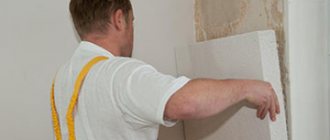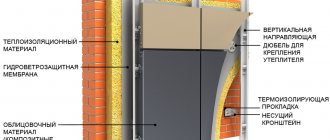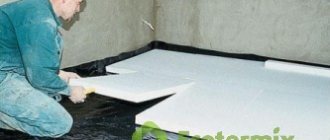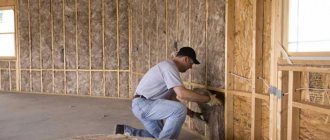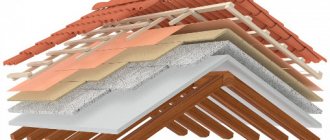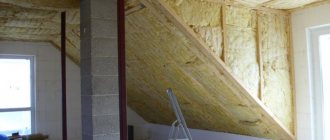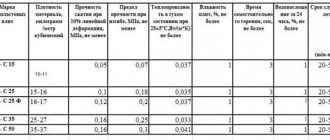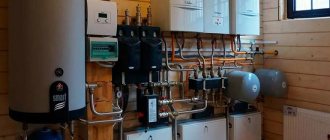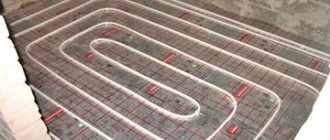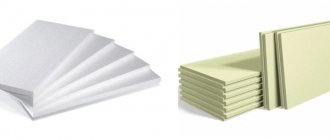Why is thermal insulation needed?
Insulation helps to increase the service life of artificial reservoirs. The walls and bottom of swimming pools are thermally insulated. Thermal insulation is performed for two reasons:
- The difference in temperature conditions between the bowl and the soil leads to rapid cooling of the water;
- Due to intense cooling, a lot of electricity is spent heating the water in the pool.
To insulate artificial reservoirs, materials with a high thermal conductivity coefficient should be used. This is due to the large temperature difference between the soil and the pool.
Features of insulation work at the initial stage
It is best to carry out thermal insulation during the preparation of concrete pouring
A swimming pool will only be built correctly if all conditions for its operation are met and reliable protection against heat loss is provided. The bowl of the pool is of particular importance in this regard. Due to the fact that it is located directly on the ground, it must be insulated with materials that have a high heat resistance coefficient. The average ground temperature is about 5-7 degrees, while the water temperature in the pool is more than 25 degrees. Taking into account the fact that heat tries to penetrate into cold areas, insulation of the pool bowl must be carried out even before installation work begins.
It is best to carry out thermal insulation during the preparation of concrete pouring. For this purpose, a small amount of penetrating substance is added to the solution. With its help, concrete will have primary thermal insulation qualities.
What are the requirements for a swimming pool site?
Most temporary pools are very, very demanding when it comes to foundation preparation. And the larger the capacity of the container, the more pronounced these requirements are.
What is most important is the presence of a perfectly flat plane lying in the absolute horizon with a deviation of no more than 2–5 mm per meter. Almost all modular pools are self-supporting, but this property only manifests itself when the load is evenly distributed. Otherwise, the walls will be deformed, and the difference in levels can lead to malfunctions of the water treatment plant.
Both inflatable and frame pools are flexible containers made of water-resistant fabric. A load of several tons of liquid is not a problem for such a tank, but the smallest pebble with sharp edges on the litter may well become one. Of course, in case of minor damage there is a repair kit, but draining 3–5 cubic meters of water is a below average pleasure.
Frame pools are more complex and, in addition to a flat and smooth base, require proper installation of supporting profiles and their fastening in the ground. This may introduce some peculiarities into the foundation preparation process.
Unforeseen difficulties
It is necessary to foresee in advance those non-obvious moments that can spoil the result even with a seemingly absolutely correct organization of the site. An example of this is rodents that tear up the soil under the pool, which causes subsidence, leading to the formation of uneven spots on the bottom and the legs falling through.
The only adequate option to combat this phenomenon is to lay galvanized metal mesh with a fine mesh (up to 10 mm) along the walls and bottom of the pit. The second method, which gives only a temporary effect, is to annually scare away earth-moving animals using a deep vibrator to shrink the concrete.
To combat rodents, you can use electronic or homemade repellers
Another problem that you may encounter when using a frame pool is the growth of trees and shrubs. Some trees have shoots that are so tough and fast growing that it is only a matter of time before they pierce the bottom of the bowl. However, the plant will not develop a root system in soil whose pH is very different from normal. Electrolyte for lead batteries, which is poured into a pit at the rate of 0.5 l/m2, will help permanently change the acidity of the soil.
Preparing the site - removing the turf and planning the soil
While small pools up to two tons can simply be placed on the lawn, this will not work with larger swimming pools. A massive “puck” will sink unevenly, and besides, the walls of the pool will almost always be damp and slippery.
Let’s start marking the area and first determine what shape “in plan” the base will take. For round pools, markings are made along a string tied to a peg in the center. Pools in the shape of a capsule are marked by two such circles connected tangentially by straight lines. Bowls with a contour close to an ellipse are drawn with three circles: one large in the center and two small ones at diametrically opposite points, then the conjugation is made manually.
The markings should outline an area that is 30–50 cm wider than the pool on each side. First, we go along the contour and undermine the turf with a shovel, driving it into the whole bayonet. We remove the top layer and take away the resulting “bumps” - good material for creating a new lawn. Using a long rule and a level, we prepare a preliminary horizontal plane, and remove the soil deposits with a shovel.
In the center of each of the holes on which the marking is based, we drive a 20 mm tube about 300 mm long so that its upper edge is at a level of minus 5 cm from the plane of the adjacent territory. For further alignment, you should prepare a radius rail - a block, through one edge of which a pin is screwed, inserted into the tube in the center. We tape the rack level tightly on top with tape, and screw a spacer board 100 mm wide from below.
Construction of a rigid and level platform
For good load distribution, we prepare a dry mixture of 10 parts of “dirty” crushed stone (PGS) and one part of grade 300 cement, which can be replaced with light crumbly clay, increasing the binder content by 1.5 times. Pour a layer of about 5–6 cm, then level it in a circle with a lath. We compact it with our feet, add more mixture and level it again.
Please note that if the pool frame requires embeddings in the ground, they must be installed before pouring the bottom layer. You just need to trim the edges a little so that the difference in the level of diametrically opposite points does not exceed 10 mm.
Now you need to twist the spacer board from the lath and pour washed quarry sand into the pit to a level of minus five centimeters to the block. Afterwards, the sand needs to be compacted with a hand tamper, the missing amount must be added, compacted again, then spilled with a small amount of water. To level, you need to stock up on a second 50 mm shorter block, which will scrape off excess sand in a circle. After alignment, do not forget to pull out the centering tube.
A damper lining is placed on top of the sand cushion. For it, most manufacturers recommend extruded polystyrene boards with a thickness of 30–50 mm. Laying should begin from the center, gluing the joints with reinforced tape. At the edges, where the contour of the pool forms roundings, the slabs are cut with a knife with an outlet 7–10 cm from the bottom of the bowl.
Next, the issue of dynamic compensation is resolved: the water in the pool works as a counter-balancer, swinging the bowl from side to side. In the plane of contact, where the pressure is very high, such vibrations can undock the substrate plates, and if there is a small pebble or sand on the surface, they will eventually wear out the bottom. Therefore, an EPS bed is covered with a slippery synthetic lining. Some people use banner fabric for this, others make do with plastic film.
Review: Frame pool Intex 54452 488x122 - This thing turned our estate into a piece of paradise
For 4 years now, our site has been decorated with a huge Intex frame pool with a diameter of almost 5 meters and a depth of 122 cm.
The idea to buy it came for the reason that, firstly, our youngest son suddenly became afraid of water and categorically did not want to learn to swim, and secondly, among the natural reservoirs nearby, we only have a fast mountain river, the water in which is quite cold even in summer.
Four and a half years ago, we bought a pool in September, during the discount period, and it cost us about $1,000. I don’t remember how much it was in rubles, I think it was around 30-32 thousand.
The kit included: the pool itself, a “galosh”, a ladder, a pump with a paper filter, a substrate under the bottom, an awning for covering the pool from above, a rope for tightening the racks, a net for removing debris with a telescopic handle,
The box stood on the veranda all winter. And then the day came (it was the last days of May 2011) when the weather allowed work on installing the pool to begin.
To begin with, we leveled the site. measuring 6x6 meters. Then they laid the backing that came with the pool, then rolled insulation (silver side down) so that the cold of the earth would not be transferred to the water. Since our soil is black soil and loose, we had to place a piece of wood cut to size under the legs.
The first time the pool was installed it took an hour and a half. In subsequent years, my husband and I, with our son helping us, spent no more than 30 minutes on installation.
Now we have a solid foundation poured under the pool in a circle 30 cm wide. Sand is poured and compacted on top of the ground inside the circle. On top of the sand, so that pebbles do not make holes in the bottom and to improve thermal insulation, we place cardboard from large boxes. Then we lay the backing. On top is insulation, but now with the shiny side up, towards the pool. And we only install the pool on insulation.
Semi-inground pool option
There are other options for foundation construction. For example, a pit for a frame pool can be dug up to one and a half meters deep so that the walls protrude only partially above the ground. Of course, such projects cannot be described as typical, because in different situations different methods of excavating soil and strengthening the walls of the pit are applicable.
By deepening the pool, you can do without an inconvenient ladder (most important for deep bowls), and in general the font looks neater and more proportional. Also, and no less important, a heavy tank will rest on a more dense layer of soil, therefore, large-volume in-ground pools are less susceptible to squeezing and tilting on soft soils.
If the preparation station has a heating function, then the pool should definitely be deepened, even if it is small in volume. It is quite easy to lay a small amount of thermal insulation near the walls of the pit, which, together with the bottom substrate, will create the effect of a thermos at least at the border of dense media, where the outflow of heat is most pronounced.
Examples
A frame pool on a base made of colored paving slabs against a green lawn looks very aesthetically pleasing. This cushion has an elevation above the ground of about 5 cm and is equipped with a border to maintain its shape and prevent the lawn from growing in the sand of the base.
In addition, the border adds convenience when mowing the lawn.
A dark-colored frame tank, located on a sand cushion decorated with light decorative stones, stands out against their background, and plant decorations make the whole composition not just a pool, but a thoughtful part of landscape design.
The wooden base for a frame pool can rest on metal pillars buried in the ground. The corners of the timber must necessarily lie in the middle of these pillars. The cross-section of the timber and the thickness of the boards are selected based on the size of the pool. The larger it is, the thicker the boards are needed.
How to make a wooden deck for a frame pool, see below.
Types of pools
Swimming pools come in various types, from special sports and recreational pools to stationary and stationary ones installed at the dacha.
Stationary
Such a pool cannot be moved around the site; a pit is dug under it and formwork is poured for the pool bowl. A place for drainage and water intake is arranged. But there are times when there is no water on the site with which to constantly fill the bowl. In this case, resort to the following solution. At the owner's request, a fire truck is brought in to fill the pool bowl with water. But what about water purification you ask? That's how. A skimmer cleaning system is installed, which, with proper care and proper use of water in the pool throughout the year, the water can not be changed for several years.
Stationary pool
Mobile
This type of pool costs the owner less than a stationary one and does not require year-round maintenance. Only for the summer swimming season. In addition, this type of pool can be moved by the owner to different parts of the summer cottage. In turn, there are several subtypes of mobile pools: inflatable and frame. The first one is one of the simplest. But it is easy to perforate if handled carelessly. The second type is more durable and durable. The water in it can not be changed all season long if a good filter is installed. But unfortunately, you have to face the following problem: many insects, in search of water, find your pool and often drown there. The most unpleasant thing is that wasps can fly in on a hot afternoon and interfere with your rest.
Making a substrate for a piece of pond with your own hands
If you don’t like film backings for custom ponds, you can make your own from wood or cement. The design of the base does not include any difficulties, but requires care and accurate calculations. So that you can make your own substrate, we will consider all the stages of preparatory and installation work in more detail.
Article on the topic: On what plain is the Lena River basin located?
Selecting a location
You need to choose a place for installing the substrate, and subsequently the pond itself, taking into account the distance to the nearest source of water supply, electricity and sewerage. Experts recommend installation on flat surfaces that have been previously cleared of construction debris and other contaminants.
Also, installation of the substrate and a piece of reservoir is possible on an uneven surface with holes, trenches and other depressions. If there are uneven areas and debris on the site, all foreign objects must first be removed and the soil leveled using sand and a tamper.
Marking
Once you have decided on the location for installing the frame pool, proceed to the next stage - applying markings. To do this you will need a can of spray paint, a tape measure, pegs and cord. If your pond is round in shape, drive a peg in the center, attach a tape measure to it and walk in a circle, making dotted marks, drawing a circle. For rectangular or square pools, use the same procedure, but using a square.
Experts recommend applying markings half a meter larger than the diameter of the pool bowl. This will help correct flaws during installation, and also, if necessary, provide space for arranging a recreation area.
Preparatory stage
In well-prepared areas, you can use ready-made film as a substrate or construct a podium yourself. In the latter case, you need to first prepare the surface: remove vegetation, weeds, stones. Next, using a bayonet shovel, the top fertile layer is cut along the contour. At the end, the area must be leveled and compacted well.
Installation of film backing
The substrate for a piece of pond must have high wear resistance and durability. Using this principle, you can select a material that meets the specified parameters: geotextiles, polypropylene. Once you have decided on the substrate, you can begin installation work. To do this, you need to lay the canvas in an even layer on the already marked, cleaned and prepared area. Upon completion, you can install a pool and arrange a recreation area.
Wooden pool podium
Most often, a wooden substrate is made from boards and beams. The latter are laid parallel to each other strictly according to the size of the reservoir or with a reserve for equipping a recreation area. Next, the boards are installed perpendicular to the beams. At the end of making the podium, the entire surface is covered with a special product that prevents the wood from rotting. A finished wooden podium has many advantages:
- looks beautiful;
- lasts a long time;
- allows you to use the site for various purposes, not limited to the installation of a pool;
- does not slip;
- protects the pool bowl from puncturing;
- retains heat, preventing the water in the reservoir from cooling quickly;
- does not fade.
Article on the topic: Is it possible to wear cosmetics in the pool?
If you want to equip a luxurious podium for swimming and relaxation, you can replace the classic boards with terrace boards. They do not rot, do not scratch, have an anti-slip coating, do not fade and are easy to clean. Such boards are available for sale in a wide range of colors and different textures, which allows you to choose the most suitable option based on your individual preferences.
Cement base
For frame pools, a cement podium is a reliable and durable solution that can solve the problem of what to put under a single-piece pond for many years. It allows you to dismantle the reservoir at any time in order to use the area for other purposes: install a gazebo, build a guest house or a workshop. When installing a cement base, consider some requirements:
- Before laying the cement pad, you need to dig a level depression in the ground that corresponds to the dimensions of the reservoir or a few centimeters more. There should be no trash, stones, sticks or leaves.
- The surface must be well compacted and level; the area can be leveled by compacting sand.
- It is imperative to construct formwork from boards.
- A special cement mortar must be mixed in accordance with the proportions.
- Before laying the cement pad, lay down layers: sand, crushed stone, reinforcing mesh.
If construction work is carried out in hot weather, the cement pad must be periodically moistened with water during the drying process. This will help prevent the surface from cracking under the influence of high temperatures.
The finished cement base can be used in its pure form or pre-decorated with paving slabs, awning fabric, vinyl film or polystyrene foam.
Insulation of a concrete pool
It can withstand the delights of the “Russian winter”, the accompanying temperature changes, mechanical stress, and is also durable and strong. It is poured into excavated soil, after which it is subject to hydro- and thermal insulation, since concrete has high thermal conductivity. If the pool is located in an area of wet soil, then the underground flow must be additionally diverted. As a result, the entire structure of the pool is safe.
Insulation of a polypropylene pool
Such artificial reservoirs made of polypropylene have become more popular because of their tightness, which every owner of this structure strives for. In addition, a propylene pool is resistant to ultraviolet rays, can be installed in the shortest possible time and is relatively cheap. Insulation reduces the heat exchange between water and slabs, which has a beneficial effect on thermometer readings. In addition, the cracks and holes that formed during the pouring of the foundation are sealed. If this is not done, then liquid from the ground or sediment will penetrate into them, which will increase during frost and render the structure unusable.
Mosaic
This material is often used in sanatoriums, hotels and other places aimed at high traffic levels of visitors. The mosaic looks the most interesting. Thanks to this material, you can create entire paintings.
The installation of this material is in many ways similar to tiles, except that the facing elements are much smaller. Their installation will take many times longer, especially if you plan to create an image. This is a labor-intensive process that you can’t always do yourself. On the other hand, mosaic (especially glass) does not absorb moisture at all and has the longest service life. It is easy to clean and does not form mold. If you skillfully combine this finishing with other decorative elements, you will get a luxurious pool.
But you will have to pay a lot for such beauty. Mosaic is more expensive than the materials described above. Most often, you also have to pay for the services of a craftsman who will lay out the panel according to your sketch. To reduce the cost of such a project, you can also use ceramic mosaic or even combine it with tiles.
Insulation of an indoor pool
This pool does not clog or bloom, and all because it is under the roof. The building itself is insulated with waterproof components, since high humidity will lead to a deterioration in the performance of the insulation over time. But this does not mean that the room does not need hydro- and steam insulation. On the contrary, the floor, walls and ceiling of a room with a swimming pool need additional insulation from moisture and excessive dampness. And since such buildings are built with thin walls, thermal insulation of the pool area is also required in order to maintain the desired microclimate.
Styrofoam
Sheets of foamed polymer are widely used as insulation for floors, walls, and ceilings of various buildings, including baths and saunas.
Sheets of foamed polymer are widely used as insulation for floors, walls, and ceilings of various buildings, including baths and saunas. These are lightweight materials consisting of cells filled with air. Due to their low weight, they can be used as insulation for a frame bath. The sheets hold their shape well and additionally provide sound insulation and wind protection to the structure.
The advantages of foam plastics are obvious: low thermal conductivity, ease of mechanical processing; ease of installation; acceptable price. If you purchase insulation from a trusted manufacturer, you can be sure of its environmental safety. Low-quality slabs may contain phenol-formaldehyde resins as a binder. These are substances that decompose when heated to form carcinogens.
The disadvantages include:
- Fragility. During installation, the sheets often break. The same thing happens with temperature changes in the log house.
- Flammability. Despite all the impregnation, the foam burns well, emitting a large amount of toxic smoke.
- The need to mount a frame. It is difficult to fix the slabs on a log wall. For reliable fastening, a lath is required.
- A large number of joints. It will not be possible to obtain a monolithic thermal insulation layer by folding it from separate sheets. There are many seams, and each of them needs additional insulation. If polystyrene foam is used as insulation for a bathhouse on the ceiling, then each joint can become a gateway for heat leakage. And cold bridges form in the walls.
- The need for additional vapor barrier. Foam plastics themselves practically do not absorb moisture; tightness is necessary to preserve wooden structures. Due to the temperature difference between the thermal insulation layer and the wall, condensation will form. Water accelerates putrefactive processes in wood and often causes an unpleasant odor in the bathhouse.
- Attractive to mice. It is quite possible that over time, many cozy holes will appear in the thickness of the insulation.
It is also worth noting that polystyrene foam can only be used as external insulation for walls. The use of this material inside a bathhouse is dangerous to human life and health.
Insulation of pool bowl walls
Heating is required during severe frosts in winter and when there is movement of groundwater. Heat loss is up to 30% through this area. In addition, this method protects the concrete base from freezing and subsequent thawing. The insulation is laid without gaps; if any are formed, they are sealed with sealants.
Thermal insulation materials for swimming pools
You cannot insulate a pool with any material you like. This will be wasted money. Because it may not be suitable and may not provide the necessary parameters. Let's figure out which material is best.
Thermal insulation membrane
The advantages of this material include:
- Mechanically strong and elastic;
- Meets all hygienic requirements;
- Very little water shedding;
- Easy to install and weld by hand;
- The welding seams are very durable and double thickened;
- Environmentally safe;
- Easy to repair;
- Can be sent for recycling.
Foam concrete
This type of material waterproofs the pool well, as it has:
- low water permeability;
- resists high pressure;
- withstands impact in aggressive water environments;
- is one of the most budget-friendly waterproofers.
Foam concrete - material for pool insulation
Styrofoam
Polystyrene foam is one of the most accessible and inexpensive types of insulation for a swimming pool, which will stop the transfer of heat from the water to the ground. Its advantages include:
- availability;
- little weight;
- environmental friendliness;
- low price;
- high thermal insulation and waterproofing properties;
- does not promote corrosion.
In addition, this material is easy to install and does not require special installations or machines.
Spray polyurethane foam
This material for thermal insulation of swimming pools is becoming popular. Suitable for most ready-made pools made of polymer and composite materials. Quick and simple surface treatment before installation in a pit provides protection from the effects of groundwater and increases the thermal insulation properties of the walls and bottom of the structure.
Note that insulation with the usual spray foam will be expensive. And this material itself is not very suitable for insulation work. In this area, low expansion polyurethane foam is used. It is characterized by greater mechanical strength, which ensures resistance to mechanical influences from the soil.
The advantages of sprayed polyurethane foam include:
- Possibility of forming an insulating coating without seams or joints. This prevents the formation of cold bridges.
- The shape of the bowl does not matter; polyurethane foam is sprayed onto curved surfaces.
- It has good adhesive properties and has stable adhesion to polymer substrates.
- The material is hygroscopic and performs waterproofing functions.
- Polyurethane foam belongs to the category of fireproof materials; it does not support flaming combustion and goes out without an open source of fire.
Let us note an important point - polyurethane foam is not resistant to ultraviolet radiation, therefore it must be isolated from sunlight. But in the case of processing a surface that is located underground, this problem is no longer relevant.
Foam spraying is also used for the outer surfaces of concrete pool bowls. But after this, the coating is reinforced and plastered using compounds that are resistant to moisture. Often this technology is used as a preliminary step before laying mosaic tiles.
What is penoplex?
The most famous of polystyrenes is polystyrene foam. Everyone knows its characteristics well, and it consists of inflated polystyrene balls, firmly glued to each other using high-temperature treatment. Penoplex is extruded polystyrene foam - a solid mass that is obtained by pressing through an extruder. Penoplex does not crumble, has a high density, is bendable and, unlike polystyrene foam, does not crumble into small pieces from external influences.
The most popular insulation materials
The insulation for the pool must have the required parameters.
The list of the most popular materials for thermal insulation of artificial reservoirs includes:
- Thermal insulation membrane;
- Foam concrete;
- Styrofoam.
The advantages of the first heat insulator include strength and elasticity, compliance with hygienic requirements. This material has minimal water absorption and is easy to install and fix by hand welding. The seams are strong and double thickened. Thermal insulation film is environmentally friendly and repairable. If necessary, it can be recycled.
Step-by-step instruction
Insulation of the bottom of a concrete pool with penoplex should be included in the design documentation and carried out in stages during construction work. After digging a pit:
- We pour 3 layers onto the bottom: sand, crushed stone, gravel (15-20 cm each).
- We produce cement screed.
- We make reinforcement (periodic profile reinforcement with anti-corrosion properties).
- We install embedded elements on the bottom: skimmers, water level regulator, flow pipe, outlets from the overflow tray, bottom drain, nozzles, etc.
- We fasten them with anti-corrosion wire. We fence with formwork.
- We cast a concrete slab - the base for the pool.
- Let it dry.
- We lay penoplex.
- We seal and connect with mastic.
- We concrete the base.
- We install the frame bowl or start finishing the concrete bowl.
It must be taken into account that the water in the pool is in constant motion, which entails vibration and influence on the bottom of the pool. Therefore, it is necessary to secure the foam blocks very hermetically and in a highly technological manner. It is better to entrust this function to craftsmen who will insulate the bottom in such a way that you do not have to “re-insulate” the bottom of the concrete pool after a couple of seasons.
The cost of penoplex starts from 150 rubles. per sheet.
Recessed or non-recessed tank
To properly insulate an in-ground pool, it must be properly deepened.
To do this you need:
- Measure the perimeter of the pool and dig a pit that will be 1 m wider than the perimeter. The depth of the pit should be no more than 2/3 of the height of the frame pool.
- Make sure that the soil or sand at the bottom of the pit is thoroughly compacted. The best option would be to concrete the surface. Before laying the insulation, make sure that the pit is perfectly level.
Only after such measures have been carried out can you proceed to the procedure for insulating the pool structure. If the pool is buried in the ground, it is additionally recommended to insulate not only the bottom, but also the sides of the pit.
External waterproofing
Groundwater can have a negative impact on the pool bowl, even to the point of its destruction. To protect pools from the destructive effects of hydrostatic pressure, groundwater is removed using drainage systems. Lowering the groundwater level is the most reliable method of protecting swimming pool bowls . A diagram of the drainage arrangement in the presence of groundwater for the pool is shown in Fig. 1.
| Rice. 1. Swimming pool drainage diagram (cross section) |
In some cases, when the groundwater level is low, external waterproofing is used. It does not allow groundwater to penetrate through the capillaries of the reinforced concrete bottom and sides into the bowl. For the manufacture of external waterproofing, various materials are used : steel, PVC films, hydroglass insulation, mastics, cement-polymer mixtures and polymer-based roll materials, clay castles, as well as various waterproofing mixtures . When performing waterproofing work, the choice of method of protection against groundwater, as well as the materials used, is very important. The price of the structure and its durability will depend on this. In addition, the quality of execution is especially important. Further, the cheapest materials can accomplish the task if performed well. But if funds allow, then it is better not to save money and purchase special roll-type membranes. They are reliable, durable and easy to install. Installation of such membranes is carried out using hot air welding using industrial hair dryers.
What should you not lay?
It is not recommended to lay natural materials under the pool bowl. They are able to absorb moisture and suffer from rot. Natural substrates not only do not fulfill their task, but also negatively affect the reservoir and destroy the prepared area.
The following materials should not be used as flooring: It is
also not recommended to use granulated foam as thermal insulation, despite the fact that it is moisture-resistant and heat-resistant: this material is often used by mice as a shelter. This leads to subsidence of the pool bowl.
Modern technologies for insulating swimming pools
One of the most popular thermal insulation technologies for swimming pools is the foam spraying method. Polyurethane foam has all the properties that a high-quality insulation should have. It does an excellent job of preventing the water in the bowl from cooling down.
Inside the artificial reservoir, polyurethane foam is polished, reinforced, and cement mortar is applied on top of it. After this, the walls and bottom of the pool are laid out with mosaics.
The bowl and pipeline are thermally insulated exclusively in stationary reservoirs; in other cases it makes no sense to do this. Mobile models do not require insulation.
The simplest option for insulating a concrete pool using polystyrene foam. Such thermal insulation does not take much time and does not require significant financial investments. Sheets of foam are usually placed around the concrete during the pouring stage. In most cases, the bottom is not insulated. In medium-depth pools with such insulation, the water does not freeze. Polystyrene foam protects the structural material from contact with moisture. Sometimes foam sheets are supplemented with expanded clay backfill, the thickness of which is 20-30 cm. It is preferable to insulate pipelines with basalt mineral wool or foil shells. A sand cushion must be poured under the heat insulator.
Insulated concrete pools are durable and the water in them does not freeze.
Possible alternatives
The following have similar properties to sheet expanded polystyrene:
branded underlays supplied by pool manufacturers;- polyurethane mats;
- rolled materials (linoleum, waterproofing membranes, polyethylene film folded in several layers, penofol, geotextiles);
- sheets of wood-polymer or mineral-based composites;
- flooring made of boards or pallets.
